Defining organic
In agriculture, the word organic has come to mean “foodstuff grown or raised without synthetic fertilizers or pesticides or hormones.” According to the USDA National Organic Standard Board, organic agriculture:
- Is an ecological production management system that promotes and enhances biodiversity, biological cycles, and soil biological activity;
- Is based on minimal use of off-farm inputs and on management practices that restore, maintain or enhance ecological harmony;
- Has a primary goal of optimizing the health and productivity of interdependent communities of soil life, plants, animals and people.

Organic vegetable gardening
As a component of organic agriculture, organic vegetable gardening promotes and enhances natural diversity and biological cycles on the farm. Rather than relying on synthetic fertilizers and pesticides, organic gardening is based on making the garden self-sufficient and sustainable.
The National Organic Program (NOP), defines the organic standards. Growers must be certified in order to claim their products are grown organically. A conventional grower can become certified organic over a three-year transition period. During this period, organic practices need to be used but the produce cannot be claimed as organic. Organic growers or gardeners with less than $5,000 in sales per year do not need to be certified but their practice has to follow the NOP standard and is subject to audit.
Most home gardeners grow vegetables naturally and do not sell produce so they do not have to strictly follow the NOP standard if the word organic is not used for their produce. For a product to be called organic, it must contain at least 95 percent USDA-certified organic ingredients.
This guide focuses on organic vegetable gardening techniques applicable to organic home or community gardeners. Commercial organic vegetable growers, however, may also find this information useful.
Transitioning to organic gardening
Producing vegetables organically is a long-term process carried out in stages rather than a single production practice adopted within one growing season. Adopting organic production techniques involves a transition from conventional to organic gardening. The first step in this transition is improving and maintaining soil fertility or quality. Healthy, fertile soils are the base of successful organic vegetable production.
The soil is a biologically active and dynamic resource, providing plants with mineral nutrients, water and oxygen. Organic matter — living organisms, fresh residues and decomposed residues is an essential ingredient in fertile and healthy soils. Organic matter improves soil tilth while preventing soil compaction and crusting. Soils low in organic matter often crust or seal over after a heavy rain, which prevents water and oxygen infiltration to the root system of growing vegetables. Organic matter slows soil erosion and provides a favorable environment for earthworms and beneficial microorganisms. Carbon dioxide from decaying organic matter brings minerals of the soil into solution, making them available to growing plants. The target level for organic matter in healthy soil is 3 to 5 percent. Potential crop yield could increase by about 12 percent for every 1 percent increase in organic matter.
Sources of organic matter
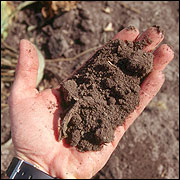
Animal manures
Animal manures are an excellent source of organic matter and nutrients for the soil. Ideally, manure should be composted according to NOP’s composting standard. Composting manure stabilizes the nitrogen and reduces the viability of weed seeds and disease pathogens that may be in the manure. Organically composted manures can be applied anytime. If fresh manure is used, apply it in the fall to fallow land and immediately plow or incorporate it into the soil to provide adequate time for breakdown and ammonia release before crops are planted. Fresh manures should not be applied directly to growing vegetable plants and should not be applied within 120 days of harvest of vegetables whose edible part touches ground, or 90 days if the edible part does not touch the ground.
The fertility of manures varies widely (Table 1). For example, poultry manure is typically higher in nitrogen and phosphorus relative to other manures. Both poultry and dairy manure have fewer weed seeds that could carryover in the garden. To interpret Table 1, note that each 100 pounds of fresh cattle manure contains 0.5 pound of available nitrogen and each 100 pounds of dried cattle manure contains about 2 pounds of available nitrogen.
Successful gardeners do not overapply manure. Similar to any fertilizer, manure can leach and pollute groundwater and streams. Also, too much nitrogen from overapplying manures can reduce the yield and quality of many vegetables.
Table 1. Major constituents of animal manures.
| Manure type | Nitrogen (N) | Phosphorus (P2O5) | Potassium (K2O) | Calcium (Ca) | Organic matter | Water content |
|---|---|---|---|---|---|---|
| Undried | ||||||
| Cattle | 0.5 percent | 0.3 percent | 0.5 percent | 0.3 percent | 17 percent | 80 percent |
| Sheep | 0.9 percent | 0.5 percent | 0.8 percent | 0.2 percent | 30 percent | 65 percent |
| Poultry | 0.9 percent | 0.5 percent | 0.8 percent | 0.4 percent | 30 percent | 65 percent |
| Horse | 0.5 percent | 0.3 percent | 0.6 percent | 0.3 percent | 27 percent | 69 percent |
| Swine | 0.6 percent | 0.5 percent | 0.4 percent | 0.2 percent | 16 percent | 78 percent |
| Dried | ||||||
| Cattle | 2.0 percent | 1.5 percent | 2.2 percent | 2.9 percent | 70 percent | 8 percent |
| Sheep | 1.9 percent | 1.4 percent | 2.9 percent | 3.3 percent | 54 percent | 11 percent |
| Poultry | 4.5 percent | 2.7 percent | 1.4 percent | 2.9 percent | 59 percent | 9 percent |
Compost
If manure is not readily available, compost can be made from lawn clippings, leaves and other plant materials. Composting organic matter stabilizes nitrogen and kills pathogens and weed seeds, and enables the use of materials, such as raw manure and sawdust, that should not be applied directly to growing vegetables.
Adding compost to garden soils improves soil structure, increases the population of beneficial microbes, increases soil moisture retention, reduces nutrient loss, boosts pH and can suppress certain diseases. Most compost contains 1 to 3 percent nitrogen. Generally, compost is applied 4 to 8 tons per acre in field vegetable production, and 10 to 20 tons per acre (1 to 2 pounds per square foot) in gardens for soil development, with 0.5 to 1 pound per square foot applied for soil fertility maintenance. For detailed information on making compost, see MU Extension publication G6956, Making and Using Compost.
Cover crops and green manures
Cover crops and green manures help build soil quality. Cover crops add organic matter, reduce soil erosion, provide habitat for beneficial insects and spiders, provide nitrogen, suppress weeds and loosen the subsoil. Green manures are cover crops that are plowed into the soil to provide nitrogen to the succeeding vegetable crop.
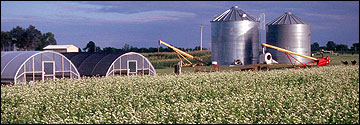
Cover crops are usually established in the fall (September to October) in Missouri and allowed to grow during the winter and early spring before being plowed in. Cover crops can be interseeded with a fall vegetable crop toward the end of the growing season, which allows the cover crop to get established during the fall vegetable crop harvest. Popular winter cover crops include annual ryegrass, winter rye, winter pea, wheat, oats, triticale, clovers and hairy vetch. Fast-growing cover crops such as buckwheat, soybean, cowpeas and sorghum-sudangrass hybrid can be established during the summer (periods of one to two months between harvest of early planted spring crops and planting of fall crops) to suppress weeds and add organic matter to the soil.
Legume cover crops, such as hairy vetch and clovers, fix nitrogen from the air and transform it for use by vegetable crops. As much as 120 pounds per acre of actual nitrogen can be fixed by certain legume cover crops one to two weeks before planting vegetable crops. Mixed seeding of grass and legume cover crops is commonly done by using one-third the normal seeding rate for the grass cover crop and two-thirds of the normal seeding rate for the legume (Table 2). Most legumes should be seeded in early fall, whereas grass cover crops can be seeded up to mid-October in Missouri. The following spring, mow or roll the cover crops. Most cereals can be incorporated into the soil when they are 24 inches tall, before head formation. Legumes should be plowed or incorporated into the soil just before full flowering for maximal nitrogen content.
Brassica and mustard cover crops are known for their rapid fall growth, great biomass production and nutrient scavenging ability. They also have potential in pest management as most Brassica species release chemical compounds that may be toxic to soil-borne pathogens and pests. Although research results are still inconsistent, these cover crops may be worth trying on a small plot for organic pest management.
Table 2. Seeding rate for select cover crop species.
| Species | Depth | Seeding rate | ||
|---|---|---|---|---|
| Drilled | Broadcast | |||
| Pounds per acre | Ounces per square 100 feet | |||
| Legumes | ||||
| Annual ryegrass | 0 to 1/2 inches | 10 to 20 | 20 to 30 | 1 |
| Barley | 3/4 to 2 inches | 50 to 100 | 80 to 125 | 3 to 5 |
| Oats | 1/2 to 1-1/2 inches | 80 to 110 | 110 to 140 | 4 to 6 |
| Rye | 3/4 to 2 inches | 60 to 120 | 90 to 160 | 4 to 6 |
| Wheat | 1/2 to 1-1/2 inches | 60 to 120 | 60 to 150 | 3 to 6 |
| Buckwheat | 1/2 to 1-1/2 inches | 48 to 70 | 50 to 90 | 3 to 4 |
| Sorghum-sudangrass | 1/2 to 1-1/2 inches | 35 | 40 to 50 | 2 |
| Brassicas | ||||
| Mustards | 1/2 to 3/4 inches | 5 to 12 | 10 to 15 | 1 |
| Radish | 1/4 to 1/2 inches | 8 to 13 | 10 to 20 | 1 |
| Rapeseed | 1/4 to 3/4 inches | 5 to 10 | 8 to 14 | 1 |
| Legumes | ||||
| Berseem clover | 1/4 to 1/2 inches | 8 to 12 | 15 to 20 | 2 |
| Cowpeas | 1 to 1-1/2 inches | 30 to 90 | 70 to 120 | 5 |
| Crimson clover | 1/4 to 1/2 inches | 15 to 20 | 22 to 30 | 2 to 3 |
| Field peas | 1-1/2 to 3 inches | 50 to 80 | 90 to 100 | 4 |
| Hairy vetch | 1/2 to 1-1/2 inches | 15 to 20 | 25 to 40 | 2 |
| Medics | 1/4 to 1/2 inches | 8 to 22 | 12 to 26 | 2/3 |
| Red clover | 1/4 to 1/2 inches | 8 to 10 | 10 to 12 | 3 |
| Subterranean clover | 1/4 to 1/2 inches | 10 to 20 | 20 to 30 | 3 |
| Sweetclovers | 1/4 to 1 inches | 6 to 10 | 10 to 20 | 1-1/2 |
| White clover | 1/4 to 1/2 inches | 3 to 9 | 5 to 14 | 1-1/2 |
| Woollypod vetch | 1/2 to 1 inches | 10 to 30 | 30 to 60 | 2 to 3 |
| Source: Managing cover crops profitably (3rd edition). 2007. Sustainable Agriculture Network. A. Clarke (ed.). | ||||
Organic fertilizers
The amount of fertilizer applied to any vegetable crop depends on soil type and characteristics (pH, organic matter and cation exchange capacity), previous cropping history and nutrient uptake by the vegetable. For example, heavy-feeding vegetables like tomatoes can remove as much as 120 pounds of nitrogen per acre each year. Soil should be tested every two years to determine total nutrients within the soil.
Table 3 lists various types of organic fertilizers that can be used to supply nutrients.
Table 3. Nutrient content of select organic fertilizers.
| Material | N | P2O5 | K | Other nutrients | Relative availability of nutrients |
|---|---|---|---|---|---|
| Rock phosphate | 0 percent | 25 percent | 0 percent | 25 percent Ca | Slow |
| Greensand | 0 percent | 0 percent | 9 percent | Slow | |
| Alfalfa pellets | 3 percent | 0.5 percent | 3 percent | Slow | |
| Bone meal (raw) | 2 percent | 15 percent | 0 percent | 20 percent Ca | Slow |
| Fish emulsion | 4 percent | 2 percent | 2 percent | 1 percent Ca | Fast |
| Blood meal | 13 percent | 0 percent | 0 percent | Slow | |
| Wood ashes | 0 percent | 2 percent | 5 percent | 20 percent Ca | Fast |
| Soybean meal | 7 percent | 2 percent | 2 percent | Medium | |
| Cottonseed meal | 7 percent | 2 percent | 2 percent | Slow | |
| Compost | 1.5 percent | 1 percent | 1.5 percent | 2 percent Ca | Slow |
| Epsom salts | 0 percent | 0 percent | 0 percent | 10 percent Mg | Fast |
| Gypsum | 0 percent | 0 percent | 0 percent | 22 percent Ca; 16 percent S | Medium |
| Corn gluten | 9.5 percent | 0.5 percent | 0.5 percent | Medium | |
| Adapted from: Ferro, D. N., ed., 1998 to 1999 New England Vegetable Management Guide, University of Connecticut, University of New Hampshire, University of Maine, University of Rhode Island, University of Massachusetts and University of Vermont. | |||||
Organic disease management
Plant diseases may seriously stunt or kill vegetable plants. Diseases often appear as leaf spots, wilts, stunts, rusts or lesions. The causal agents may be fungi, bacteria, viruses or mycoplasms, or a stressful environment. For example, many vegetable plants will wilt not only from too little water but also from excessive water in the root zone. The key to successful organic disease management is prevention. The following strategies can be used to prevent diseases on vegetable crops.
Resistance or tolerance
Whenever possible, choose disease-resistant vegetable varieties. Disease resistance means that although a plant may occasionally contract the disease, it will not be seriously affected. Tolerance to a disease means that the plant usually contracts the disease when present but is able to survive despite the infection. The seed package usually lists disease resistance information of the variety, especially for hybrid (F1) varieties.
Disease-free transplants
Many vegetables can be established as transplants. Carefully inspect transplants for any spots or lesions on the stems or leaves. Remove a few transplants from the planting container and inspect their root systems. Healthy roots are white or light in color, and show no signs of decay or excessive wrapping of the fibrous roots around the root ball. Avoid buying plants that have already set fruit.
Site selection
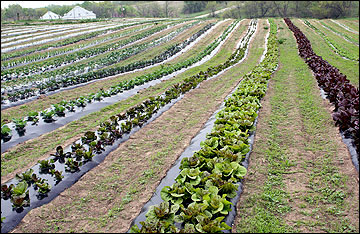
Always choose a well-drained soil for growing vegetables. Root rots and other soil-borne diseases thrive in wet soils. Low spots in the field also are pockets of high humidity in the plant canopy, creating a favorable environment for diseases. Avoid planting close to trees or buildings that may reduce air circulation or the intensity or duration of sunlight. Use raised beds to promote soil aeration and drainage whenever possible
Crop rotation
Crop rotation is a long-established, successful agricultural practice. Continuous cropping of plants in the same botanical family allows for buildup of disease organisms. Vegetables that are in the same botanical family should not be grown in the same area for at least three years. For example, watermelon, cucumber, squash, cantaloupe and pumpkins are in the Cucurbitaceae family and often are attacked by the same disease organisms. Rotating curcurbits with vegetables in the Solanaceae family such as peppers, tomatoes, eggplants or potatoes can potentially lower the incidence of diseases.
Plant spacing and training
Dense plantings can often increase susceptibility to diseases. By increasing the spacing between plants, air circulation and light intensity are enhanced, creating a less favorable environment for disease development. Always stake or cage tomato plants to keep the plants and fruit from touching the soil. Remove suckers (lateral buds) up to the node below the first fruit cluster on a tomato plant to increase air circulation and light exposure and thus reduce disease incidence.
Mulching
Organic mulches such as straw, hay, compost, newspaper or wood shavings will aid in disease prevention by reducing direct contact between soil and the plant. Mulch thickness should be 4 to 6 inches. Many soil-borne diseases infect the plant from rain-splashed soil on the lower leaves. Organic mulches usually lower soil temperatures. Thus, warm-season vegetables such as tomatoes and peppers should be mulched only after the soil has warmed. Plastic mulches also can be used by organic growers. Plastic mulches are available in a variety of colors and are particularly effective in warming the soil. Black plastic is the most commonly used plastic mulch for spring and early summer vegetables in Missouri. Infrared-transmitting (IRT) plastic mulch allows certain wavelengths to penetrate the plastic, increasing the soil temperature significantly more than black plastic mulch. Growers wishing to plant later in the summer can use white plastic to keep the soil cooler. When plastic mulch is used, water must be supplied by a drip tube or soaker hose under the plastic.
Rogue infected plants
Root out and destroy any plant showing severe disease symptoms to prevent the spread to adjacent plants. Plants infected by viruses should be removed from the garden immediately.
Sanitation
To prevent carryover of plant diseases from one growing season to the next, clean all planting trays and growing supplies such as wooden tomato stakes, planting trays and harvest containers. Most materials can be soaked in a hydrogen peroxide solution or steam sterilized. Plant residues in a garden should be cleaned and removed. Do not compost diseased plant residue. Eliminate weeds around the perimeter of the garden because these can serve as hosts for plant diseases.
Seed saving
Many diseases are seed borne. Some organic gardeners save seed from favorite varieties. When saving seed, make sure the plants from which the seeds were harvested have no disease symptoms. Do not save seeds from a hybrid variety because the plants from those seeds usually segregate and thus produce a mixed crop.
Organic pesticides
Organic fungicides for vegetables include copper (Bordeaux mixtures or sulfates), hydrogen peroxide, and sodium bicarbonate (baking soda). When using baking soda, gardeners need to watch for the buildup of sodium, which can be toxic to plants. High concentration (70 percent) of Neem oil can be used to kill powdery mildew spores. Biological fungicides, which are beneficial bacteria or fungi, are available to organic gardeners. Most organic fungicides are applied to prevent the development of a disease. The Organic Materials Review Institute (OMRI) reviews and approves materials to be used in organic production and continually updates its lists of approved and disqualified organic materials. Organic growers should check the OMRI list or consult the certifier before applying any new chemical.
Protected crop culture
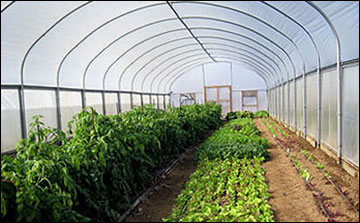
High tunnels, or hoop houses, are plastic-covered, solar greenhouses that lengthen the traditional growing season and protect the growing vegetable crop from rain, wind, hail and erratic temperatures. High tunnels also exclude many pests that routinely attack vegetable plants in the Midwest. Most diseases need free moisture to become activated. Diseases are less likely to develop in a high tunnel because drip irrigation is used and the plant canopy is kept dry. More information about high tunnels is available in MU Extension publication M170, High Tunnel Tomato Production.
Vegetable grafting
Grafted vegetables (tomato, watermelon, melon, cucumber, pepper and eggplant) usually have better resistance to soil-borne diseases, more vigor and higher yield than non-grafted ones. The advantages come from the rootstock. Growers who prefer growing heirloom varieties, have limited garden space, or produce vegetables in a high tunnel or greenhouse should consider this emerging technique.
Organic weed management
Weeds are plants that compete with vegetables for light, water and nutrients. Weeds also interfere with harvesting and can harbor many diseases. Although completely eliminating weeds in the garden is not realistically possible or necessary, several strategies in addition to hoeing or hand-weeding can be employed to reduce weed competition.
Reduce the weed seed bank
Raw manure, immature compost, hay or straw may contain weed seeds. Clean tillage or harvesting equipment after use to prevent contamination from adjacent fields. Do not allow weeds to form seed heads.
Mulches
Mulches shade the soil to prevent weed seed germination and smother the growth of weeds. Both organic and plastic mulches are available to gardeners. Mulches can be added to the crop throughout the growing season, or the crop can be seeded or transplanted into an established mulch, a practice called conservation tillage. Cover crops can be grown during the summer to suppress weeds for the fall garden.
Rotation
Rotating the garden with cover crops or different types of vegetables may prevent the buildup of a single weed species.
Plant spacing
The critical weed-free period for most warm-season vegetable crops is about 45 days after planting. After that, plant canopy will be big enough to shade the weeds and inhibit their growth. Thus, early-season weed control is critical. Reasonably decreasing the spacing between plants or between rows so that the crop shades the soil rapidly can aid in weed management.
Cultivation
Till garden soil three or four weeks before planting, and allow weeds to germinate and emerge. The weeds can be tilled into the soil several times before the crop is established. This technique, called a stale seedbed method, reduces the weed population by breaking their natural cycle of emergence in the vegetable garden.
Vegetable type
Certain vegetables are relatively more competitive with weeds. For example, Irish and sweet potatoes, winter squash, sweet corn and tomatoes can effectively compete with weeds.
Transplanting
Use transplants if possible. They enable a uniform stand of the crop and give the vegetable plants a head start over any weeds that emerge.
Flame weeding
Flame weeding, or using a hot flame to kill weeds, is effective for stale seedbed weed removal or weeds that emerge before the vegetable crop. Flame weeding is effective for weed control in slow-germinating vegetables such as onions, parsnips and carrots. Some growers have successfully used flame weeding on transplanted onions that were 8 to 10 inches tall. Sweet corn that has just emerged and potatoes up to 2 inches tall can be flame weeded.
Drip irrigation
Drip irrigation reduces weed emergence by reducing the soil area that receives water.
Solarization
Clear plastic spread across an area where crops will be planted can kill weeds, weed seeds and even some plant pathogens. Apply the plastic close to the ground during the hot part of the year and leave it in place for four to six weeks.
Organic herbicides
Organic gardeners can use various organic herbicides, including acetic acid (vinegar), citric acid and corn gluten meal to control weeds.
Organic insect management
Organic management of insect pests is based on avoiding a pest outbreak rather than dealing with the pest after it has acquired a foothold in the garden. The following are a few techniques that can be used to control insects organically:
Inspect plants
Scout the garden often, specifically the border or outside rows. Physically remove any harmful insects found to prevent the population from spreading to adjacent plants.
Habitat for beneficial insects
Create an environment favorable for natural enemies of harmful insects. More than 100 families of insects, spiders and mites contain species that are natural enemies of harmful insects. Plant the borders of the garden in native flowers or plants such as clover or alfalfa to attract beneficial insects such as lady beetles.
Row covers
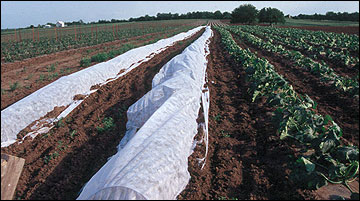
Row covers are lightweight, spunbonded fabrics that can be suspended or draped over vegetables to protect them from invasive insects. Row covers are particularly effective in reducing damage by flea beetles and cucumber beetles. Applying row cover to parthenocarpic cucumbers, zucchinis or other vegetables that do not need pollination to fruit can greatly reduce insect damage.
Trap crops
Plant a less desirable plant close to the garden to attract insects away from the important vegetables in the garden. Destroy the trap crop after it becomes infested with insects.
Resistant crops
Some varieties or types of vegetables are less attractive to insects. For example, County Fair pickling cucumber is much less attractive to cucumber beetles than most other cucumber varieties.
Date of planting
Many vegetable insects will have peak populations throughout the growing season. Avoid high populations of insects by adjusting the planting date. For example, early-planted sweet corn will have much less corn earworm infestation than late-planted corn.
Intercropping
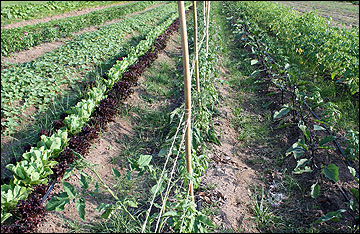
Intercropping is the practice of growing two or more vegetables in the same area during the same growing season. Avoid planting large blocks of any single vegetable in the garden. Mixing vegetables prevents spread and buildup of harmful insects.
Keep plants healthy
Healthy plants are less attractive to insects, and if attacked, are better able to survive and produce a marketable crop. This is also true for organic disease management.
Sanitation
Remove plants after harvest to prevent them from becoming reservoirs for harmful insects.
Fall plowing
Plowing the vegetable garden after fall harvest exposes insects and insect eggs to birds or to desiccation during winter freezing and thawing.
Organic insecticides
Several organic insecticides are available for use by vegetable gardeners, including Bt (Bacillus thuringiensis), pyrethrums, rotenone, insecticidal soaps, diatomaceous earth, neem and horticultural oils. Check the labels and consult your certifying agency before using any insecticides.